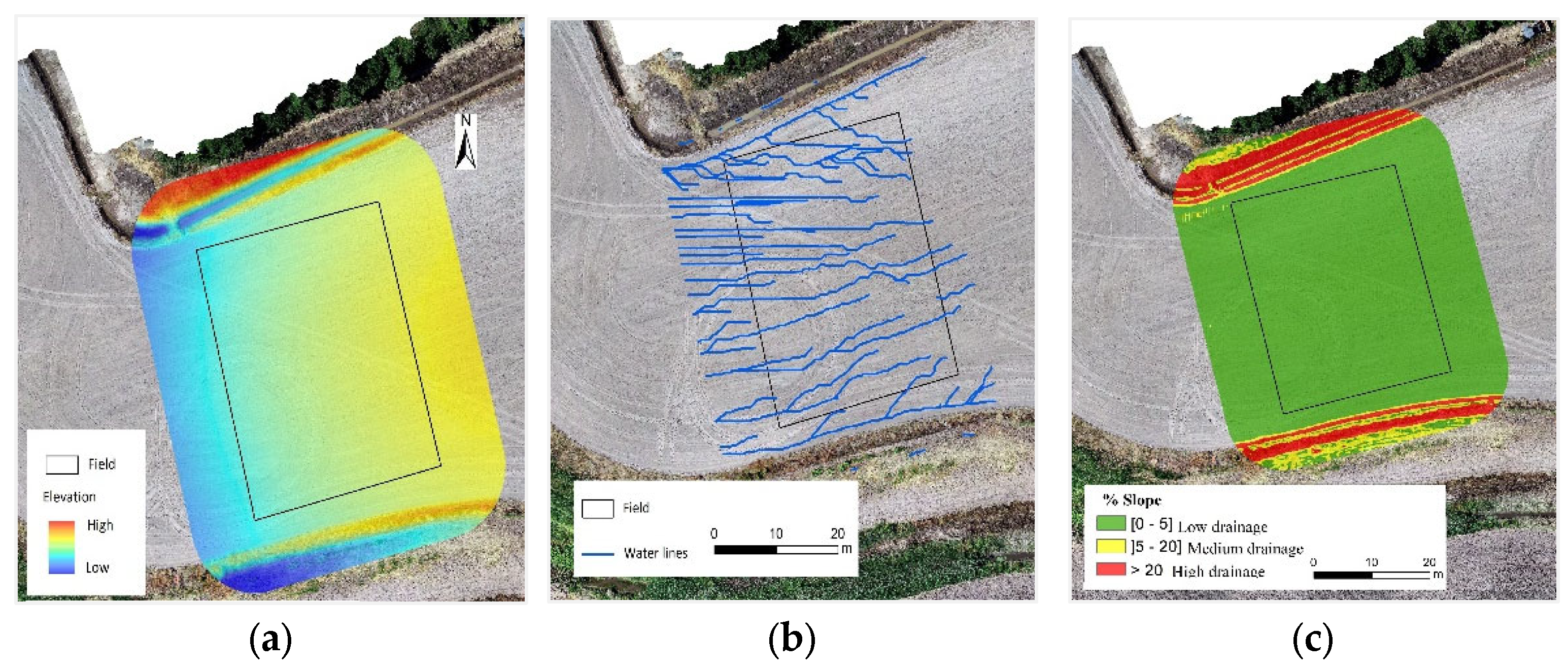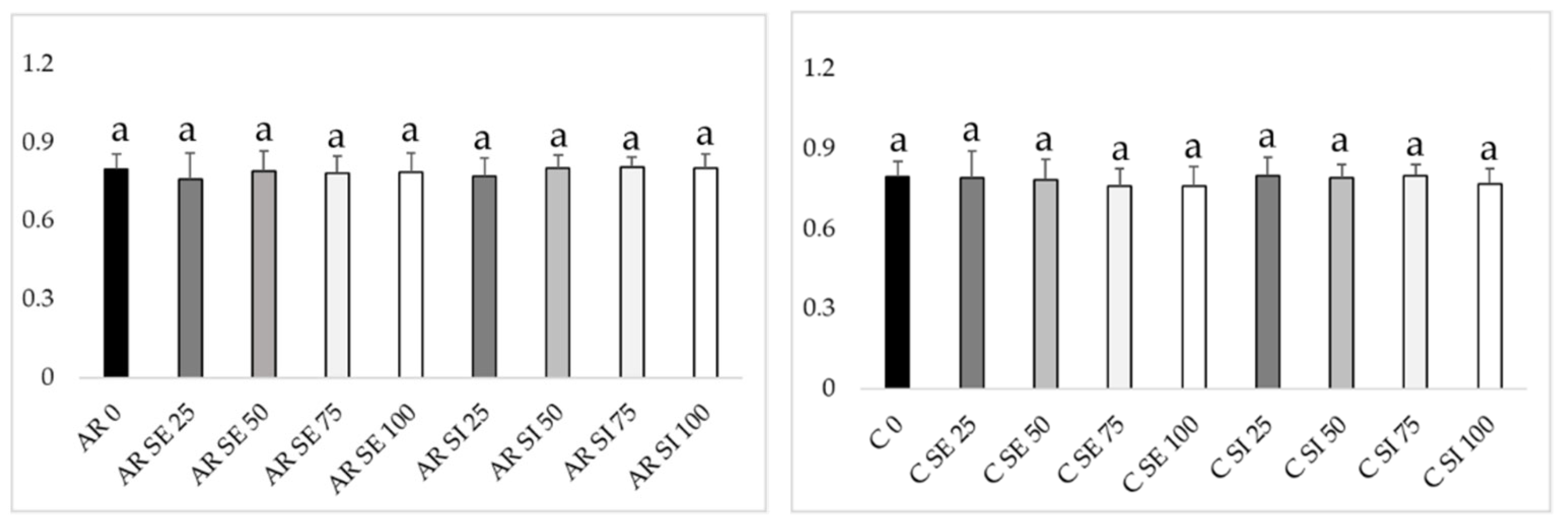Precision Agriculture in Rice (Oryza sativa L.) Biofortified with Selenium †
Abstract
:1. Introduction
2. Materials and Methods
2.1. Experimental Fields and Selenium Biofortification
2.2. Precision Agriculture—Experimental Fields and Monitoring the State of the Rice Culture
2.3. Leaf Gas Exchange Measurements
2.4. Analysis of Selenium Content
2.5. Statistical Analysis
3. Results
4. Discussion
5. Conclusions
Author Contributions
Funding
Institutional Review Board Statement
Informed Consent Statement
Data Availability Statement
Acknowledgments
Conflicts of Interest
References
- Shafi, U.; Mumtaz Shafi, U.; Mumtaz, R.; García-Nieto, J.; Hassan, S.A.; Zaidi, S.A.R.; Iqbal, N. Precision agriculture techniques and practices: From considerations to applications. Sensors 2019, 19, 3796. [Google Scholar] [CrossRef] [PubMed]
- Chen, X.; Ma, J.; Qiao, H.; Cheng, D.; Xu, Y.; Zhao, Y. Detecting infestation of take-all disease in wheat using Landsat Thematic Mapper imagery. Int. J. Remote Sens. 2007, 28, 5183–5189. [Google Scholar] [CrossRef]
- Reis, A.; El-Ramady, H.; Santos, E.F.; Gratão, P.L.; Schomburg, L. Overview of selenium deficiency and toxicity worldwide: Affected areas, selenium-related health issues, and case studies. Plant Ecophysiol. 2017, 11, 209–230. [Google Scholar] [CrossRef]
- Lyons, G.H.; Genc, Y.; Stangoulis, J.C.; Palmer, L.T.; Graham, R.D. Selenium distribution in wheat grain, and the effect of postharvest processing on wheat selenium content. Biol. Trace Elem. Res. 2005, 103, 155–168. [Google Scholar] [CrossRef] [PubMed]
- Coelho, A.R.F.; Lidon, F.C.; Pessoa, C.C.; Marques, A.C.; Luís, I.C.; Caleiro, J.; Simões, M.; Kullberg, J.; Legoinha, P.; Brito, M.; et al. Can foliar pulverization with CaCl2 and Ca(NO3)2 trigger Ca enrichment in Solanum tuberosum L. tubers? Plants 2021, 10, 245. [Google Scholar] [CrossRef] [PubMed]
- Rodrigues, W.P.; Martins, M.Q.; Fortunato, A.S.; Rodrigues, A.P.; Semedo, J.N.; Simões-Costa, M.C.; Pais, I.P.; Leitão, A.E.; Colwell, F.; Goulao, L.; et al. Long-term elevated air [CO2] strengthens photosynthetic functioning and mitigates the impact of supra-optimal temperatures in tropical Coffea arabica and Coffea canephora species. Glob. Chang. Biol. 2016, 22, 415–431. [Google Scholar] [CrossRef] [PubMed]
- Cardoso, P.; Mateus, T.; Velu, G.; Singh, R.P.; Santos, J.P.; Carvalho, M.L.; Lourenço, V.M.; Lidon, F.; Reboredo, F.; Guerra, M. Localization and distribution of Zn and Fe in grains of biofortified bread wheat lines through micro and triaxial-X-ray spectrometry. Spectrochim. Acta Part B At. Spectrosc. 2018, 141, 70–79. [Google Scholar] [CrossRef]
- Wang, Y.; Liu, W.; Li, J.; Liu, D. Effects of topography and soil properties on runoff generation in a small watershed on the Chinese Loess Plateau. J. Hydrol. 2018, 565, 762–770. [Google Scholar]
- Sukojo, B.M.; Kurniawan, R.H. Rice growth stages mapping with Normalized Difference Vegetation Index (NDVI) algorithm using sentinel-2 time series satellite imagery. Int. J. Adv. Sci. Eng. Inf. Technol. 2021, 11, 1594. [Google Scholar] [CrossRef]
- Wall, L.; Larocque, D.; Leger, P.M. The early explanatory power of NDVI in crop yield modelling. Int. J. Remote Sens. 2008, 29, 2211–2225. [Google Scholar] [CrossRef]
- Peng, S.; Huang, J.; Sheehy, J.E.; Laza, R.C.; Visperas, R.M.; Zhong, X.; Centeno, G.S.; Khush, G.S.; Cassman, K.G. Rice yields decline with higher night temperature from global warming. Proc. Natl. Acad. Sci. USA 2004, 101, 9971–9975. [Google Scholar] [CrossRef] [PubMed]
- Jiang, C.; Zu, C.; Lu, D.; Zheng, Q.; Shen, J.; Wang, H.; Li, D. Effect of exogenous selenium supply on photosynthesis, Na+ accumulation and antioxidative capacity of maize (Zea mays L.) under salinity stress. Sci. Rep. 2017, 7, 42039. [Google Scholar] [CrossRef] [PubMed]
- Ramalho, J.C.; Roda, F.A.; Pessoa, M.F.G.; Reboredo, F.H.; Pais, I.P.; Ndayiragije, A.; Lidon, F.C.; Ribeiro-Barros, A.I. Selenium agronomic biofortification in rice: Improving crop quality against malnutrition. In The Future of Rice Demand: Quality beyond Productivity; De Oliveira, A.C., Pegoraro, C., Viana, V.E., Eds.; Springer: Cham, Switzerland, 2020; pp. 179–203. [Google Scholar] [CrossRef]
- Thavarajah, P.; Vial, E.; Gebhardt, M.; Lacher, C.; Kumar, S.; Combs, G.F. Will selenium increase lentil (Lens culinaris Medik) yield and seed quality? Front. Plant Sci. 2015, 6, 356. [Google Scholar] [CrossRef] [PubMed]
- Li, H.F.; McGrath, S.P.; Zhao, F.J. Selenium uptake, translocation and speciation in wheat supplied with selenate or selenite. New Phytol. 2008, 178, 92–102. [Google Scholar] [CrossRef] [PubMed]



| Fertilization | Ariete | Ceres |
|---|---|---|
| Pn (μmol CO2 m−2.s−1) | ||
| Control | 15.80 ± 0.24 a 1 | 16.66 ± 0.32 c |
| Selenate 50 | 16.89 ± 0.70 a | 17.20 ± 0.33 ab |
| Selenate 100 | 16.43 ± 0.36 a | 17.60 ± 0.31 a |
| Selenite 50 | 16.70 ± 0.21 a | 16.84 ± 0.68 bc |
| Selenite 100 | 16.18 ± 0.24 a | 17.82 ± 0.10 a |
| gs (mmol H2O m−2.s−1) | ||
| Control | 182.4 ± 5.9 c | 242.9 ± 8.7 b |
| Selenate 50 | 307.4 ± 11.0 ab | 266.0 ± 3.3 ab |
| Selenate 100 | 320.7 ± 18.7 b | 275.3 ± 4.4 ab |
| Selenite 50 | 280.6 ± 1.4 b | 263.4 ± 24.8 ab |
| Selenite 100 | 368.6 ± 23.0 a | 313.7 ± 15.3 a |
| E (mmol H2O m−2.s−1) | ||
| Control | 3.81 ± 0.06 d | 5.86 ± 0.13 b |
| Selenate 50 | 5.56 ± 0.10 c | 5.99 ± 0.01 b |
| Selenate 100 | 5.90 ± 0.20 b | 6.28 ± 0.09 ab |
| Selenite 50 | 5.13 ± 0.02 bc | 6.10 ± 0.29 ab |
| Selenite 100 | 6.66 ± 0.20 a | 6.81 ± 0.15 a |
| iWUE (mmol CO2 m−2.s−1 H2O) | ||
| Control | 4.15 ± 0.01 a | 2.84 ± 0.01 ab |
| Selenate 50 | 3.03 ± 0.06 c | 2.86 ± 0.05 a |
| Selenate 100 | 2.81 ± 0.08 d | 2.80 ± 0.03 b |
| Selenite 50 | 3.25 ± 0.03 b | 2.77 ± 0.03 b |
| Selenite 100 | 2.44 ± 0.05 e | 2.63 ± 0.05 b |
Disclaimer/Publisher’s Note: The statements, opinions and data contained in all publications are solely those of the individual author(s) and contributor(s) and not of MDPI and/or the editor(s). MDPI and/or the editor(s) disclaim responsibility for any injury to people or property resulting from any ideas, methods, instructions or products referred to in the content. |
© 2023 by the authors. Licensee MDPI, Basel, Switzerland. This article is an open access article distributed under the terms and conditions of the Creative Commons Attribution (CC BY) license (https://creativecommons.org/licenses/by/4.0/).
Share and Cite
Marques, A.C.; Pessoa, C.C.; Daccak, D.; Luís, I.C.; Coelho, A.R.F.; Simões, M.; Scotti-Campos, P.; Almeida, A.S.; Brito, M.G.; Kullberg, J.C.; et al. Precision Agriculture in Rice (Oryza sativa L.) Biofortified with Selenium. Biol. Life Sci. Forum 2023, 27, 14. https://doi.org/10.3390/IECAG2023-14993
Marques AC, Pessoa CC, Daccak D, Luís IC, Coelho ARF, Simões M, Scotti-Campos P, Almeida AS, Brito MG, Kullberg JC, et al. Precision Agriculture in Rice (Oryza sativa L.) Biofortified with Selenium. Biology and Life Sciences Forum. 2023; 27(1):14. https://doi.org/10.3390/IECAG2023-14993
Chicago/Turabian StyleMarques, Ana Coelho, Cláudia Campos Pessoa, Diana Daccak, Inês Carmo Luís, Ana Rita F. Coelho, Manuela Simões, Paula Scotti-Campos, Ana Sofia Almeida, Maria Graça Brito, José Carlos Kullberg, and et al. 2023. "Precision Agriculture in Rice (Oryza sativa L.) Biofortified with Selenium" Biology and Life Sciences Forum 27, no. 1: 14. https://doi.org/10.3390/IECAG2023-14993
APA StyleMarques, A. C., Pessoa, C. C., Daccak, D., Luís, I. C., Coelho, A. R. F., Simões, M., Scotti-Campos, P., Almeida, A. S., Brito, M. G., Kullberg, J. C., Ramalho, J. C., Semedo, J. M. N., Guerra, M., Leitão, R. G., Reboredo, F., Silva, M. M., Legoinha, P., Pessoa, M. F., Palha, L., ... Lidon, F. C. (2023). Precision Agriculture in Rice (Oryza sativa L.) Biofortified with Selenium. Biology and Life Sciences Forum, 27(1), 14. https://doi.org/10.3390/IECAG2023-14993



















